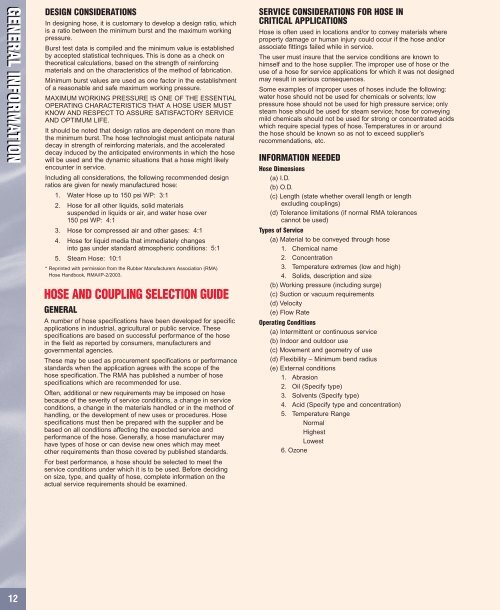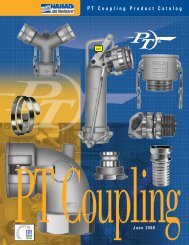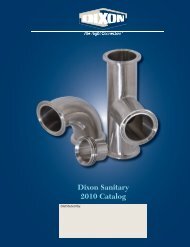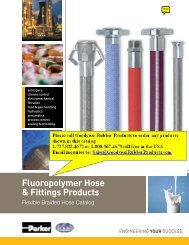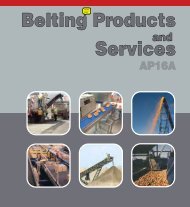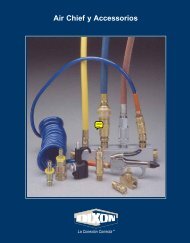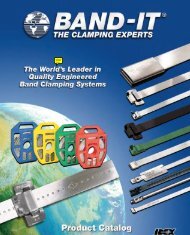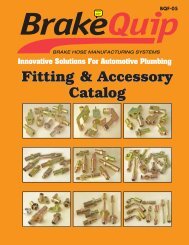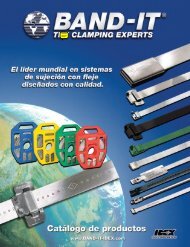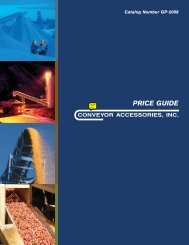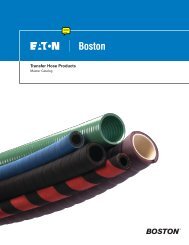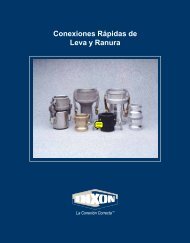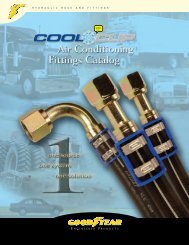HOSE PRODUCTS
Thermoid Industrial Hose Division - Goodyear
Thermoid Industrial Hose Division - Goodyear
- No tags were found...
Create successful ePaper yourself
Turn your PDF publications into a flip-book with our unique Google optimized e-Paper software.
GENERAL INFORMATION<br />
DESIGN CONSIDERATIONS<br />
In designing hose, it is customary to develop a design ratio, which<br />
is a ratio between the minimum burst and the maximum working<br />
pressure.<br />
Burst test data is compiled and the minimum value is established<br />
by accepted statistical techniques. This is done as a check on<br />
theoretical calculations, based on the strength of reinforcing<br />
materials and on the characteristics of the method of fabrication.<br />
Minimum burst values are used as one factor in the establishment<br />
of a reasonable and safe maximum working pressure.<br />
MAXIMUM WORKING PRESSURE IS ONE OF THE ESSENTIAL<br />
OPERATING CHARACTERISTICS THAT A <strong>HOSE</strong> USER MUST<br />
KNOW AND RESPECT TO ASSURE SATISFACTORY SERVICE<br />
AND OPTIMUM LIFE.<br />
It should be noted that design ratios are dependent on more than<br />
the minimum burst. The hose technologist must anticipate natural<br />
decay in strength of reinforcing materials, and the accelerated<br />
decay induced by the anticipated environments in which the hose<br />
will be used and the dynamic situations that a hose might likely<br />
encounter in service.<br />
Including all considerations, the following recommended design<br />
ratios are given for newly manufactured hose:<br />
1. Water Hose up to 150 psi WP: 3:1<br />
2. Hose for all other liquids, solid materials<br />
suspended in liquids or air, and water hose over<br />
150 psi WP: 4:1<br />
3. Hose for compressed air and other gases: 4:1<br />
4. Hose for liquid media that immediately changes<br />
into gas under standard atmospheric conditions: 5:1<br />
5. Steam Hose: 10:1<br />
* Reprinted with permission from the Rubber Manufacturers Association (RMA)<br />
Hose Handbook, RMA/IP-2/2003.<br />
<strong>HOSE</strong> AND COUPLING SELECTION GUIDE<br />
GENERAL<br />
A number of hose specifications have been developed for specific<br />
applications in industrial, agricultural or public service. These<br />
specifications are based on successful performance of the hose<br />
in the field as reported by consumers, manufacturers and<br />
governmental agencies.<br />
These may be used as procurement specifications or performance<br />
standards when the application agrees with the scope of the<br />
hose specification. The RMA has published a number of hose<br />
specifications which are recommended for use.<br />
Often, additional or new requirements may be imposed on hose<br />
because of the severity of service conditions, a change in service<br />
conditions, a change in the materials handled or in the method of<br />
handling, or the development of new uses or procedures. Hose<br />
specifications must then be prepared with the supplier and be<br />
based on all conditions affecting the expected service and<br />
performance of the hose. Generally, a hose manufacturer may<br />
have types of hose or can devise new ones which may meet<br />
other requirements than those covered by published standards.<br />
For best performance, a hose should be selected to meet the<br />
service conditions under which it is to be used. Before deciding<br />
on size, type, and quality of hose, complete information on the<br />
actual service requirements should be examined.<br />
SERVICE CONSIDERATIONS FOR <strong>HOSE</strong> IN<br />
CRITICAL APPLICATIONS<br />
Hose is often used in locations and/or to convey materials where<br />
property damage or human injury could occur if the hose and/or<br />
associate fittings failed while in service.<br />
The user must insure that the service conditions are known to<br />
himself and to the hose supplier. The improper use of hose or the<br />
use of a hose for service applications for which it was not designed<br />
may result in serious consequences.<br />
Some examples of improper uses of hoses include the following:<br />
water hose should not be used for chemicals or solvents; low<br />
pressure hose should not be used for high pressure service; only<br />
steam hose should be used for steam service; hose for conveying<br />
mild chemicals should not be used for strong or concentrated acids<br />
which require special types of hose. Temperatures in or around<br />
the hose should be known so as not to exceed supplier’s<br />
recommendations, etc.<br />
INFORMATION NEEDED<br />
Hose Dimensions<br />
(a) I.D.<br />
(b) O.D.<br />
(c) Length (state whether overall length or length<br />
excluding couplings)<br />
(d) Tolerance limitations (if normal RMA tolerances<br />
cannot be used)<br />
Types of Service<br />
(a) Material to be conveyed through hose<br />
1. Chemical name<br />
2. Concentration<br />
3. Temperature extremes (low and high)<br />
4. Solids, description and size<br />
(b) Working pressure (including surge)<br />
(c) Suction or vacuum requirements<br />
(d) Velocity<br />
(e) Flow Rate<br />
Operating Conditions<br />
(a) Intermittent or continuous service<br />
(b) Indoor and outdoor use<br />
(c) Movement and geometry of use<br />
(d) Flexibility – Minimum bend radius<br />
(e) External conditions<br />
1. Abrasion<br />
2. Oil (Specify type)<br />
3. Solvents (Specify type)<br />
4. Acid (Specify type and concentration)<br />
5. Temperature Range<br />
Normal<br />
Highest<br />
Lowest<br />
6. Ozone<br />
12


